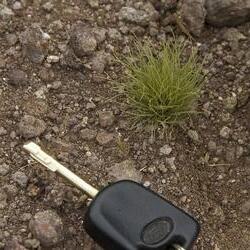Herbs, annual or perennial, cespitose, scapose, not rhizomatous. Roots diffuse, very fine. Culms stiff or flaccid, usually terete, ribbed. Leaves basal, polystichous, spreading to ascending; sheaths open apically, apex fimbriate-ciliate, rarely entire; ligules absent, lateral tufts of hair at junction of blade and sheath; blades mostly linear or filiform, coarsely ribbed, usually longer than sheaths, 1 mm wide or less, mostly strongly involute, margins variably scabrid-ciliate. Inflorescences terminal on slender scapes, rarely axillary to culm leaves, simple or compound anthelae or spikelet solitary; spikelets 1–50+; involucral bracts (1–)2–8, spreading or erect, leaflike or scalelike. Spikelets mostly ovoid to lanceoloid or lance-cylindric; scales 6–50, spirally arranged, rarely nearly distichous, each subtending flower or 1–2 proximal scales empty. Flowers bisexual; perianth absent; stamens 1–3; styles slender, (2–)3-fid, glabrous, base enlarged, persistent in fruit. Achenes trigonous or 3-lobed, rarely biconvex, usually 3-ribbed.
Spikelets mostly in simple or compound, often umbelliform cymes (or virtually a head) forming a terminal infl subtended by 2–several slender, ± lf-like invol bracts; scales spirally imbricate; fls perfect; perianth none; stamens 1–3; style trifid, the unbranched portion smooth, the base enlarged and usually persistent on the trigonous achene as a tubercle (minute in our spp.); radicle basal; herbs with mostly basal, filiform to narrowly linear lvs, the sheath long-ciliate or fimbriate at the top. 80+, mainly trop. B. stenophylla (Elliott) C. B. Clarke, a coastal plain sp., closely approaches our range in N.C. and may be sought in se. Va. The stems have a single dense terminal cluster of virtually sessile spikelets, subtended by elongate, setaceous invol bracts.
Herbs, annual [or perennial]. Culms tufted, very slender. Leaves with a leaf blade or rarely reduced to a bladeless sheath, mouth with lax white hairs; leaf blade filiform to linear, margin often involute. Involucral bracts leaflike or setaceous. Inflorescence a terminal simple or compound anthela or capitate, sometimes reduced to a single spikelet. Spikelets ovoid to ellipsoid, many flowered. Glumes spirally arranged or rarely distichous, herbaceous or membranous, deciduous, subtending a flower but basal 1 or 2 empty. Flowers bisexual. Perianth bristles absent. Stamens (1 or)2(or 3). Style filiform, base thickened, bulbous, and persistent in fruit; stigmas 3. Nutlet obovoid to obpyriform, 3-sided.
Pubescent annuals or perennials with slender culms, leafy below, the leaves narrowly linear or filiform with ciliate or pubescent sheaths; spikelets umbellate, capitate or solitary, sometimes appearing lateral on the culm, with 1 or more sub-tending bracts or sterile scales; scales pubescent, spirally imbricated, usually deciduous; style 3-cleft, with an enlarged base (tubercle) sometimes constricted below and usually persistent on the apex of the achene; perianth lacking; achene trigonous, rarely lenticular, with longitudinally elongate cells and frequently with a papillose-roughened surface; stamens 1-3.

